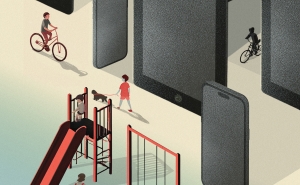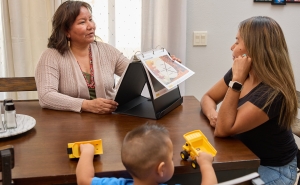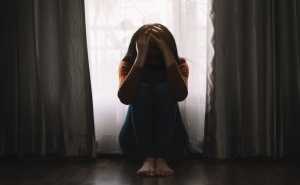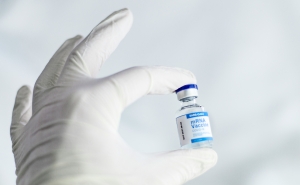Coping with COVID-19’s Evolving Mental Health Toll
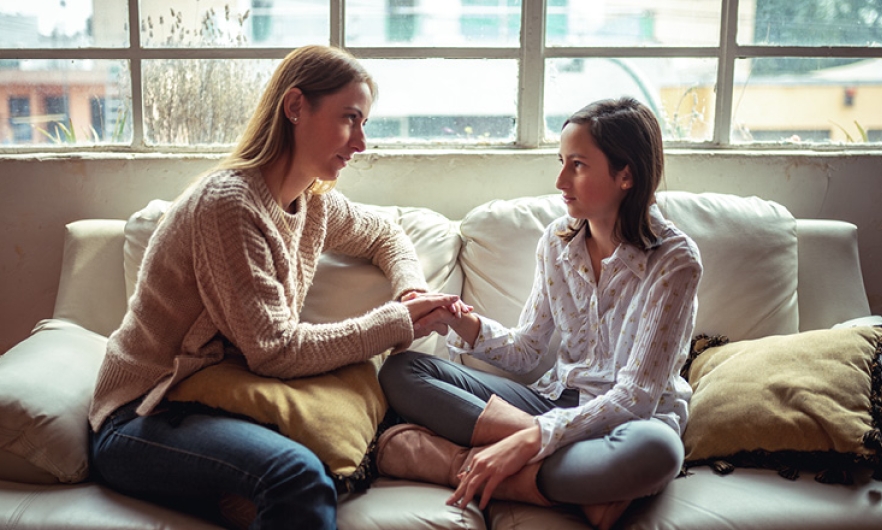
A psychologist offers tips for helping kids and adults deal with impacts of the ongoing pandemic.
INTERVIEW BY STEPHANIE DESMON
As the coronavirus pandemic wears on, disruptions to everyday life exact a continuing mental health toll on adults and children alike.
Last month, clinical psychologist Laura Murray, PhD, MA, a senior scientist in the Bloomberg School’s departments of Mental Health and International Health, spoke with Stephanie Desmon of the Johns Hopkins Center for Communication Programs about COVID-19’s evolving mental health impacts. In this Q&A, adapted from that conversation, Murray discusses sobering statistics from the CDC and offers suggestions for talking to kids about the pandemic, reaching out to others, and addressing our own unproductive thoughts and worries.
Stephanie Desmon: In a recent CDC survey, 75% of 18- to 21-year-olds reported at least one mental or behavioral health symptom, and a quarter said they had a serious suicidal ideation. Talk to me about that.
Laura Murray: Those are very high rates, for sure. We’re seeing more and more of these surveys come out about the mental health aspects of COVID-19 over time, and I think there are a few things to look at.
First of all, we should take these seriously. We need to make sure we keep reaching out to those around us, our friends, our loved ones, maybe even people we don’t know that well. Try not to be shy about reaching out and just checking in, and making sure you give some self-disclosure—This is really hard for me too, I’d love to talk with you about it—because I think we do need to take these numbers into account.
The other thing to keep in mind with these surveys is that we are all living through a situation that is higher stress, and so we’re going to see higher numbers of stress reported. The stress is so wide and diverse. Sometimes it has to do with health, sometimes it has to do with economics, and a number of other things. So we need to keep in mind that this is somewhat of a normal reaction to a really crazy and different time that we’re going through.
And then the other thing to keep in mind is that most of these surveys—including, I believe, the CDC survey—didn’t do a formal evaluation as far as diagnostics, so they’re asking people baseline questions. There is still cause for concern, of course. COVID has created a time where all of us need to be reaching out to those who we see may not be themselves, and if anyone themselves feels “off,” they should also reach out.
SD: Let’s talk a little bit about all the things kids are missing out on. How can we get kids to talk about their feelings?
LM: Being a parent, you really realize not only that you have to of course pay attention to kids, but that all kids are different. Our daughter might be experiencing something very different than our son, and that’s something that parents should be very mindful of right now, especially because kids have less interaction with other adults. There were always different teachers or coaches around our kids. And now parents might be some of the only people actually observing their kids and how they’re doing.
Make sure that you are asking kids how they’re feeling, and make sure there’s an open line of communication. Now, that’s awkward for most kids, especially from parents. They’re like, “Oh God, mom, do not ask how I’m feeling.” So, a couple of tips for this:
One is to use self-disclosure. Say, “Oh gosh, today was a really hard day. I was at the grocery store and someone had their mask down and they sneezed, and I got really anxious.” Or “I haven’t been able to see my friends,” or “We haven’t been able to see grandpa and grandma for so long, and I’m just feeling sad about that.” That opens up the conversation a little bit more without that targeted question of “How are you feeling?”
Another idea is to ask about thoughts. So you might say, “Let’s all give one thought about this crazy coronavirus.” It just opens up those lines of communication a little bit more so it’s not a taboo subject, it’s not something that they avoid.
It’s an opportunity for us to share, “I’m really fatigued with this whole coronavirus,” or “I’m ready for it to be over.” Just as an example, I got one response from my daughter, who is tired of it, but my son said, “I’m actually enjoying it. The whole family’s home.”
SD: One thing I’m seeing is this numbing to COVID. When the first lockdowns were happening and I had to go to the store, my heart was pounding, and I was so nervous with everything that I did. And I went to the grocery store the other day, and it was just like going to the grocery store any other day. What’s happening here?
LM: What’s happening is that we as human beings perceive risks that are acute—like a hurricane or a tsunami—very differently than chronic risk, like car accidents, for example, or, now, COVID. It’s moving into more of a chronic view in our minds because it’s been with us [since March].
In psychology we talk about habituation: the more we’re sensitized to something, it becomes less of a threat, less intimidating. I think it’s happening everywhere, and it’s just something to be aware of that’s probably going on with everyone a little bit.
SD: Is that dangerous, though? If we are getting used to this extreme risk, are we going to take more chances? Are we going to put ourselves at higher risk unknowingly?
LM: I think it depends on who you ask. There’s a lot being written about this now that we’re moving from acute to chronic, so it’s something to keep your eye out for.
I think scientists are worried that people are getting to a point where they’re sending their kids to camp, and now they’re sending their kids to school, and everyone’s going to the grocery store, and they’re worried about this and wondering how many more rules do we have to make in order to pull our behavior back? I don’t think that means that everyone’s taking crazy risks. I think people maybe are weighing risks in a different way.
SD: I accidentally touched my face after I was at the grocery store before I used hand sanitizer, and now I keep thinking that it never would have happened in March. And so here I am worrying that I’ve now infected myself.
LM: This is something we’re working with a lot of people on—trying to distinguish between productive worries or thoughts and unproductive ones. A lot of us have moments like you had. For example, my son had a baseball game. We were distanced, and outside, and lots of people were wearing masks, but still, you start to question these things.
It is time to take a step back for our own mental health and say, OK, is this a worry that’s productive? Is this something that’s going to make me go back to my decision base? Or is this something that’s just getting me spiraling out of control and leading to some of these statistics [on mental health] that the CDC and others are finding?
SD: I have one more question here about compassion and blame. We’re all seeing people who aren’t “following the rules,” or maybe are making decisions that we wouldn’t make. I read something about how people are not posting pictures of their vacation on Facebook because they feel like maybe they shouldn’t have gone on vacation. Even if they took all the precautions, they don’t want to advertise to the world that they did this.
LM: I’m in the same boat. I mean, I am second guessing decisions left and right, and most of the people we talk to are also.
I think compassion is such a great word. I do think it’s harder to achieve than it is to talk about. When we talk about compassion, we’re saying we want to infuse ourselves with some sort of positive feeling that we’re doing the best we can with tough decisions and, quite frankly, a lot of uncertainty.
Having compassion for yourself means accepting uncertainty, accepting that there is no right answer. One of the best ways to do that is monitor what you’re saying to yourself. Are you saying to yourself, I shouldn’t have made that decision, or What if this, or what if that, versus That’s the decision I made, and we’ve got to move on.
One of the analogies I really love in psychology is that having a thought doesn’t mean you’ve actually bought into the thought. I tend to have a thinking mistake of catastrophizing. So I would be like you: If I touched my eye, I’d be like, That’s it. I have COVID. That’s just where my mind goes.
What’s interesting is to say instead, Here is my mind going again, which is normal, but I’m not going to buy into those thoughts. And here’s the thought I’m actually going to buy into. So it’s not necessarily about stopping those thoughts, but about recognizing that our brains are going to do this, and we’re all going to have days of doubt, but trying to move beyond that on to accepting uncertainty and just having a little compassion for ourselves and, of course, for others.
Stephanie Desmon is the cohost of the Public Health on Call podcast. She is the director of public relations and marketing for the Johns Hopkins Center for Communication Programs, the largest center at the Bloomberg School of Public Health.
RELATED CONTENT
Public Health On Call
This conversation is excerpted from the August 28 episode of Public Health On Call.
More from the Bloomberg School
- See latest headlines
- Learn more about our departments:

